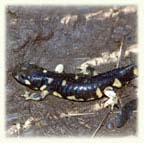|
 News News
 Subscribe to Our Newsletter Subscribe to Our Newsletter
 Sign up for Email Updates
Sign up for Email Updates
 CGF In the News
CGF In the News
 Press Inquiries Press Inquiries
 Past Articles Past Articles
 Calendar Calendar
Habitat Conservation Plan/
Natural Community Conservation Plan Resources
City of San Jose
County of Santa Clara
Santa Clara Valley Water District
California Dept. of Fish & Game
U.S. Fish and Wildlife Service - HCP Homepage
U.S. Fish and Wildlife Service - Conservation Plans and Agreements Database
National Wildlife Federation
Defenders of Wildlife
|
|
|
Regional planning in south San Jose:
The HCP/NCCP process
by Judy Fenerty
The widening of
Highway 101 and other development projects in south San Jose have triggered a complex regional planning process which will result in a Habitat Conservation Plan (HCP) as required by the federal Endangered Species
Act and a Natural Community Conservation Plan (NCCP) in accordance with state law. In 2001, the County of Santa Clara, the Santa Clara Valley Water District, the Valley Transportation Authority and the City of San
Jose agreed to participate in this planning process and have been working with other agencies and consultants to create a strategy for developing these plans.
  The threatened Bay checkerspot butterfly (Euphydryas editha bayensis), their food source, Tidy Tips (Layia platyglossa), and
the endangered California tiger salamander (Ambystoma californiense) will be considered in the Santa Clara County HCP/NCCP. The threatened Bay checkerspot butterfly (Euphydryas editha bayensis), their food source, Tidy Tips (Layia platyglossa), and
the endangered California tiger salamander (Ambystoma californiense) will be considered in the Santa Clara County HCP/NCCP.
When Habitat Conservation Plans were added to the federal
Endangered Species Act (ESA) in 1982, the intent was to minimize and mitigate impacts to threatened and endangered plant and animal species while allowing development to proceed
through the issuance of "incidental take" permits to developers and landowners. Although some HCPs can be very small, covering only a few acres, many cover entire counties or other large areas.
By contrast, the NCCP process was passed into law in 1991 and seeks to develop plans for natural communities based on an ecosystem approach. Although the federal ESA targets plants and
animals already considered threatened or endangered, the NCCP process can encourage more proactive conservation planning for species not yet formally listed.
The scope and size of the HCP for Santa Clara County have not yet been determined, but the HCP will almost certainly address multiple species and a significant portion of the County. Some of
the threatened and endangered species that might be affected by the HCP/NCCP process include the bay checkerspot butterfly, the California red-legged frog, the California tiger salamander and
a number of plants unique to serpentine grassland habitats.
Santa Clara County's HCP/NCCP process is expected to take four to five more years to complete, and offers us an opportunity
to ensure protections for sensitive species, habitats, and communities in this special region. Environmental organizations - including the Committee for Green Foothills, the Santa Clara Valley Chapter of the California Native Plant Society, and the Santa Clara Valley Audubon Society
- are already working with local agencies to ensure that these plans are developed with the best environmental science available to provide the greatest
benefit to rare plants and animals.
Judy Fenerty is the Vice President of the Santa Clara Valley Chapter of the California Native Plant Society.
Published March 2003 in Green Footnotes.
Page last updated March 19, 2003 . |
|
![]()
![]()




